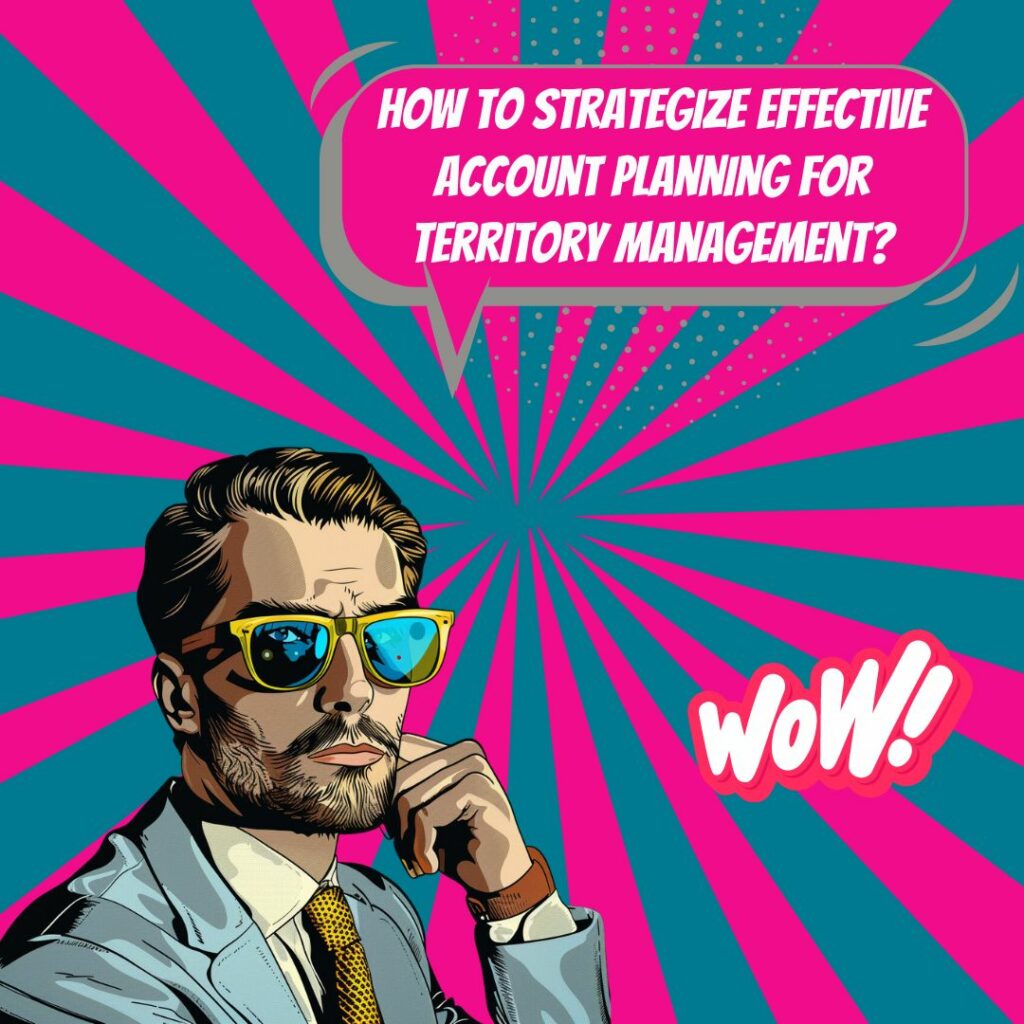Key Takeaways
✅ Plan Accounts Effectively: Discover how to carve out a sales roadmap by pinpointing lucrative market segments and smartly allocating resources. By leveraging insights like customer acquisition cost (CAC), you can trim down expenses while amping up sales. Secure an optimal sales landscape by ensuring territories are distributed equitably, focusing on key factors like deal size, geographic areas, and industry sectors. This approach not only streamlines overhead costs but significantly boosts sales output.
✅ Implement Regional Sales Strategies: Segment your sales territories to better distribute resources and elevate your sales game. Embrace cutting-edge tools like CRM software and territory mapping solutions for fine-tuned territory planning, identifying overlaps or gaps. Crafting a detailed management blueprint for prospecting and customer interaction sharpens your team's focus and drives productivity.
✅ Better Coverage: Match sales representatives with territories that play to their strengths to enhance sales results. A strategic rotation schedule keeps customer contacts fresh without overburdening. Balancing the pursuit of current high-value customers with the hunt for new leads cultivates a robust sales strategy.

Introduction
Are you tired of hitting the same roadblocks in your sales strategy? Maximize Territory Management might just be your golden ticket to breaking through those barriers. This isn’t just about drawing lines on a map; it’s about drafting a blueprint for unprecedented success. Effective territory management can transform your sales team from good to exceptional, directing their energy towards the most fertile grounds for growth.
By diving into this writing, you’re signing up for a deep dive into planning accounts effectively and adopting regional sales strategies that promise better coverage. Venturing beyond traditional practices, we unlock modern methodologies and embrace technological advancements that refine territory allocation. With an aim to elevate ROAS and ROI, this article isn't just another read; it's your step towards optimizing sales performance.
Prepare to unveil actionable insights and groundbreaking strategies that can revolutionize your approach to territory management. Whether you aim to scale new heights in sales revenue or wish to make your mark with innovative sales strategies, the key lies within managing your territories wisely. Let’s embark on this journey of transformation, charting a course towards amplifying efficiency, coverage, and, ultimately, sales success.
Top Statistics
| Statistic | Insight |
|---|---|
| 76% of companies conduct territory planning once per year | This shows a lot of businesses believe in setting their territories annually, yet almost half see the value in more dynamic planning. |
| Less than 40% of companies feel they can effectively measure key data in territory design | A glaring indicator of the challenges in gathering actionable insights, which are crucial for optimizing sales territories. |
| 83% of organizations still use spreadsheets for territory design moderately or frequently | Despite the technological advancements available, a large majority still relies on manual methods, showcasing a significant area for improvement and efficiency gains. |
| Companies using technology in territory design had 10% higher achievement of sales objectives than the average | This emphasizes the benefit of integrating technology into the planning process, not just for design but also for reaching sales goals. |
| 76% of respondent companies assign territories by geography | Though geography is the most common factor for territory division, emerging technologies allow for more sophisticated methods to be explored. |
Understanding the Importance of Territory Management
Have you ever wondered why some businesses seem to grow their customer base effortlessly while others struggle? A large part of the answer could lie in effective territory management. This strategy is not just about dividing a map among sales representatives; it's about ensuring teams focus their energy on the most promising prospects and opportunities. By assigning specific regions to sales teams, companies can reduce time wasted on less productive leads and enhance overall success rates. Think of it as making sure your best players are on the field where they are most needed. Effective territory management also leads to better customer coverage and increased market penetration. Ultimately, it creates a more organized and efficient sales process.
Creating a Winning Sales Territory Plan
The backbone of any successful sales strategy is a well-thought-out territory plan. But what does it include? A plan that brings results should clearly define objectives, territories, and customer segmentation. It's not enough to just draw lines on a map and assign people; it involves understanding where your potential customers are and what they need. Moreover, it involves a continuous cycle of analyzing and reassessing performance to ensure the plan's effectiveness. Regular performance metrics analysis plays a crucial role in this, as it highlights where adjustments may be needed. Incorporating feedback from sales teams can also refine the strategy. Keeping the plan dynamic and adaptable ensures it remains relevant over time.
Implementing Regional Sales Strategies for Better Coverage
Achieving comprehensive coverage across regions requires meticulous sales territory alignment. By breaking down larger areas into manageable territories, each account manager can focus more effectively on their set of customers. This focused approach helps in building stronger relationships and providing tailored solutions to clients. Imagine a sales rep who knows every client's name, preferences, and needs in their territory. This level of personal attention is what sets companies apart in today's competitive market. Effective regional strategies also facilitate quicker response times to customer inquiries. They can lead to more meaningful interactions and higher customer satisfaction.
Optimizing Territory Coverage
Optimizing territory coverage is about smart prioritization and leveraging technology. Using data analysis to identify high-value prospects and allocating resources accordingly ensures that efforts are concentrated where the biggest returns are expected. Modern tools like CRM systems and mapping software can significantly enhance this process, making it easier to visualize opportunities and plan routes efficiently. Essentially, it's about working smarter, not harder, to reach the most lucrative opportunities first. Regularly updating and analyzing territory data helps maintain optimal coverage. It also allows for strategic adjustments based on market trends and sales performance.
Measuring Success in Territory Management
But how do we know if all these efforts are paying off? Measuring success in territory management requires looking at several key performance metrics, including sales revenue, customer acquisition, customer retention, and customer satisfaction. Regularly evaluating these indicators allows businesses to pinpoint what's working and what's not. Adjustments to strategies can then be made in a timely manner, ensuring continuous improvement and growth. Tracking these metrics over time provides insights into long-term trends and performance. Benchmarking against industry standards can also highlight areas for improvement.
Best Practices for Training and Developing Territory Managers
To excel in territory management, sales representatives need more than just basic sales training. They require comprehensive instruction in territory planning, customer segmentation, and the use of technological tools. Beyond classroom training, on-the-job experiences and coaching are invaluable for developing practical skills. Continuous learning and development opportunities are essential for keeping territory managers at the top of their game, able to tackle the challenges of an ever-evolving marketplace. Regular workshops and training sessions can keep managers updated on the latest strategies and tools. Encouraging a culture of knowledge sharing within the team can also enhance collective performance.
By focusing on these key areas, businesses can create a robust framework for territory management, leading to greater efficiency, higher sales, and improved customer relationships. Whether you're just starting or looking to refine your existing strategy, the key lies in planning, implementing, and continually optimizing your approach. Adopting best practices and leveraging technology will position your sales team for sustained success.
AI Marketing Engineers Recommendation
Recommendation 1: Leverage Data Analytics for Strategic Account Selection: Utilize data analytics tools to analyze customer demographics, sales history, and market trends to identify high-potential accounts within each territory. By focusing on accounts with the highest potential for growth, you can allocate your resources more effectively and increase your return on investment. For instance, businesses that implemented targeted data analytics saw up to a 15% increase in their sales productivity, according to a recent survey.
Recommendation 2: Employ Geographic Information Systems (GIS) for Optimized Territory Coverage: GIS technology assists in visualizing and analyzing geographical data, enabling sales teams to understand their territories better and plan their routes more efficiently. By integrating GIS with your sales strategy, you can ensure better coverage of your territories, reduce travel time and costs, and improve customer satisfaction. Research indicates that companies using GIS for territory management have witnessed a 5-10% reduction in travel time and expenses.
Recommendation 3: Implement Customer Relationship Management (CRM) Software with Territory Management Features: CRM software that includes territory management capabilities allows for better tracking of customer interactions, sales opportunities, and performance metrics across different regions. This ensures that your team is aligned and can collaborate effectively, leading to increased sales and customer retention rates. Businesses that have integrated CRM systems with territory management features report a 12% higher customer satisfaction score and a 10% increase in sales revenue.
Conclusion
In the realm of sales, the maximization of territory management stands as a pillar that holds up the vast canopy of success. Throughout this article, we have journeyed through the ins and outs of planning accounts effectively and implementing regional sales strategies for better coverage. This strategy is not just about drawing lines on a map; it's about understanding and harnessing the potency of effective territory management. From carving out a comprehensive sales territory plan with clear objectives and strategic customer segmentation to the fine art of optimizing territory coverage using data analysis and technology tools, the path to enhancing sales efficiency and productivity has been clearly laid out.
The unfolding narrative has also underscored the importance of fine-tuning the approach through regular performance metrics analysis, ensuring that each step taken is a step towards greater success. Moreover, the strategy involves more than just planning and analysis; it requires a human touch. Training and developing territory managers with a mix of classroom instruction, on-the-job experiences, and ongoing support forms the backbone of a strategy that is as dynamic as the market itself.
As the article wraps up, it's essential to reflect on how these insights and strategies are not just methods but a mindset that champions continuous improvement and adaptation. Whether you're just stepping into the world of sales or you're looking to refine your territorial management approach, the lessons outlined here stand as a beacon to guide your way. Let this exploration serve as a catalyst for action. Embrace these strategies, implement them, and watch as your sales territory not only grows in coverage but thrives in efficiency and productivity.
FAQs
Question 1: What is territory management?
Answer: Territory management is all about divvying up territories to sales reps and making sure these territories are set up in a way that's fair, covers customers properly, and has room for growth. Think of it as mapping out a strategy for your sales team to conquer the business world, one region at a time.
Question 2: What is the difference between territory planning and territory management?
Answer: Territory planning is like the brainstorming session. It's where you decide who gets which slice of the pie, creating the territories. Territory management? That’s when you roll up your sleeves and get down to business, managing and fine-tuning those territories for the best sales performance.
Question 3: How do you determine the best criteria for territories?
Answer: You look at who your customers are (like what size companies they are, what industry they're in, or what they're buying) and match that with the sales team that's best equipped to serve them. It's like matchmaking but for business profits.
Question 4: How can technology improve territory management?
Answer: Technology is like a crystal ball that actually works. It gives you data-driven insights, helps automate the grunt work, and can even optimize the routes your sales team takes. AI can spot trends and opportunities you might miss otherwise, making it easier to go after the right sales strategies.
Question 5: What are some best practices for territory management?
Answer: Focus on your goldmine territories, keep an eye on the competitors by tracking data, and do everything you can to keep your sales team productive and efficient. It's about working smarter, not just harder.
Question 6: How do you ensure buy-in from all stakeholders?
Answer: Talk about it— a lot. Share your plans visually on maps, and listen to what people on the ground have to say. Keeping everyone in the loop minimizes grumbles and gets everyone rowing in the same direction.
Question 7: Why is clean data crucial for territory management?
Answer: Dirty data is like trying to read a map with coffee spills all over it. Regular clean-ups make sure your territory management software gives you the clear direction you need to make informed decisions.
Question 8: How do you balance sales territories?
Answer: It's like making sure everyone at the dinner table gets a fair share of the pie—enough to feel satisfied but not so much they can't manage. This keeps your sales team happy, your customers satisfied, and your business thriving.
Question 9: What are the pillars of territory management?
Answer: Think of it as a three-legged stool: sales territory design, sales territory planning, and sales territory optimization. Each stage is about dividing up the market strategically, coming up with action plans, and then making sure things are as efficient and effective as possible.
Question 10: How do you set achievable quotas?
Answer: Quotas should match the potential of the territory. It's about setting the bar high enough to motivate but not so high that it's out of reach. It's finding that sweet spot where reps feel driven to outdo themselves but can actually reach the targets set.
Academic References
- Sales Territory Planning and Management. This article emphasizes the importance of strategic sales territory planning and management to ensure efficient allocation of resources and maximize sales potential. It outlines steps to create an effective sales territory plan, including analyzing market segments, setting sales quotas, and aligning sales teams with customer needs.
- Best Sales Territory Management. This guide highlights the dual focus of sales territory management, which includes providing services to high-value accounts and developing relationships with potential new customers. It emphasizes the need for a comprehensive plan to optimize sales efforts and improve customer relationships.
- Efficient Sales Territory Plan. This article provides a five-step approach to creating an efficient sales territory plan, including market analysis, customer segmentation, SWOT analysis, and setting sales quotas. It emphasizes the importance of understanding customer needs and aligning sales strategies accordingly.
- Sales Territory Management Tips. This article offers seven tips for effective sales territory management, including dividing territories strategically, creating call rotation plans, and aligning salespeople with their strengths. It emphasizes the need for a structured approach to maximize sales potential.
- Profitable Sales Territory Plans. This resource provides a seven-step template for creating profitable sales territory paid, including setting goals, measuring sales potential, and focusing sales efforts strategically. It emphasizes the importance of a well-planned approach to achieve maximum success.











